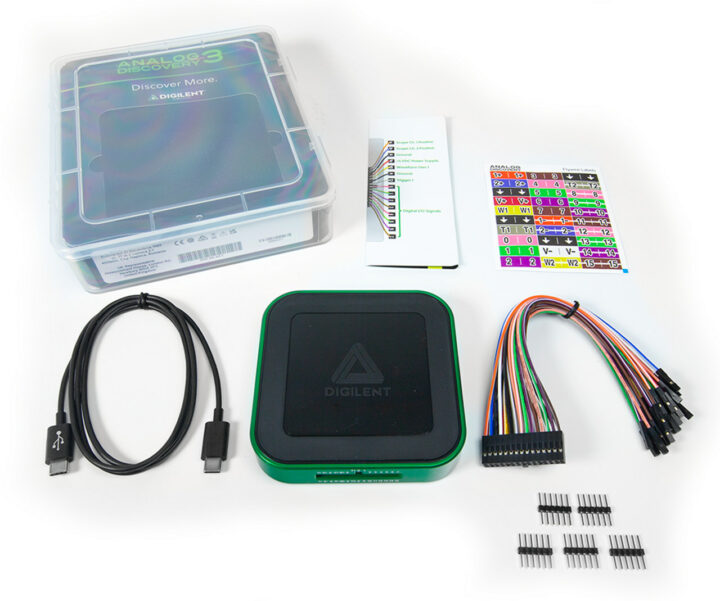Digilent Analog Discovery 3 is a USB oscilloscope with a sample rate of up to 125 MS/s, that can also be used as a waveform generator, logic analyzer, and/or a variable power supply up to 5V.
Several other features are also enabled through its software and the USB-C oscilloscope can also act as a spectrum analyzer, a network analyzer, an impedance analyzer, a protocol analyzer, a data logger, a voltmeter, and supports in-app scripting.
Analog Discovery 3 features highlights:
- Xilinx FPGA-based design
- Host interface – USB Type-C port
- Oscilloscope
- 2x differential channels with 14-bit resolution at up to 125 MS/s per channel with a +/-25 V input range, 30+ MHz bandwidth with BNC Adapter
- User-configurable input filters and lock-in amplifier
- FFT, Spectrogram, Eye Diagram, XY Plot views, and more
- Arbitrary Waveform Generator
- 2x channels with 14-bit resolution at up to 125 MS/s per channel with a +/-5 V output range, 12 MHz bandwidth with BNC Adapter
- Standard waveforms, amplitude, and frequency modulated signals, direct playback from analog inputs, custom waveforms, and more
- Logic Analyzer and Pattern Generator
- 16x digital I/O channels at up to 125 MS/s per channel
- Individually-configurable 3.3 V digital inputs and outputs, 5 V tolerant inputs
- SPI, I2C, UART, CAN, JTAG, ROM logic, custom protocols, and more
- Programmable Power Supplies
- 0.5 V to 5 V and -0.5 V to -5 V variable power supplies
- Up to 800 mA per channel when used with an auxiliary power source
The USB oscilloscope relies on WaveForms software for Windows, Linux, macOS, and some Arm devices such as the Raspberry Pi SBC. The program enables the use of the available analog and digital instruments and provides an SDK for hardware control in C, C++, Python, and other languages, as well as support for LabVIEW and MATLAB integration.
The Analog Discovery 3 ships with a plastic project box, a USB-C to USB-C programming cable, one 2×15 flywire signal cable assembly, a pack of five 6-pin male headers, and 30-pin flywire labels, and the company recommends 5V/2.5A or 5V/4A switching power supplies, the Audio Adapter+, a BNC Adapter along with the P2150 BNC Oscilloscope Probe, a Transistor Tester, an Impedance Analyzer, and a Breadboard Adapter to make full use of the kit.
 Digilent will start selling the Analog Discovery 3 for $379 from June 14 onwards
Digilent will start selling the Analog Discovery 3 for $379 from June 14 onwards
Via Hackster.io

Jean-Luc started CNX Software in 2010 as a part-time endeavor, before quitting his job as a software engineering manager, and starting to write daily news, and reviews full time later in 2011.
Support CNX Software! Donate via cryptocurrencies, become a Patron on Patreon, or purchase goods on Amazon or Aliexpress. We also use affiliate links in articles to earn commissions if you make a purchase after clicking on those links.








While the specs seem quite good, they need to fix those wires. Those jumper wires are really going to do shit.
You need a proper probe setup.
Sounded nice until i saw the price 🙂
This doesn’t seem to be a good deal. For this amount a person can purchase – Hantek 6074BE 4 CH 1GSa/s USB oscilloscope + DS Logic Plus 16 CH 400MHz sample rate USB-based Logic Analyzer + Raspberry Pi Pico which can be used as 12-bit 250 MS/s arbitrary waveform generator. In my opinion many western companies like Digilent are quite out of touch with current prices and market trends.
Many western companies (except ones that want very high volumes) are less than eager to deal with chinese companies while doing business. That’s their market, and it isn’t small.
You are massively missing the point of a device like this. Sure you could go and get the equipment you suggest but to use them together it is a lot more effort than just using the analog discovery. With the analog discovery you can use and synchronise the scope and wavegen functions to do things like frequency sweeps, network analysis, impedance analysis and curve tracing, all with just the press of a few buttons in waveforms. You can also then mix in the digital input and output functions too.
On top of all that it has an SDK and compatibility with labview and matlab so you can control it through those too.
That 250 MS/s pi pico AWG is severely limited in functionality to most other AWGs.
You can download the waveforms software for free and use it in demo mode to see what is all possible with the analog discovery boards if you wanted.
I have an original Analog Discovery and an ADP3450. They are both extremely useful when doing pretty much anything on a breadboard. If the signals are too fast for the probe wires (for the Analog Discovery), they are probably too fast to use a breadboard anyway. Using a USB isolator floats everything simplifying differential probing. Also, waveforms is incredibly useful – both out of the box and through scripting. Yesterday I had to capture timing information in a digital signal plus serial data on a separate line (RS-422). An off-the-shelf RS-422 converter and a custom script in waveforms gave me a dump of all transitions and all RS-422 data with timestamps. It was 30 minutes of work with waveforms.
Is there OpenSource Software that works with the hardware?
yes, sigrok project aim to handle wide varity of hardware avaliable